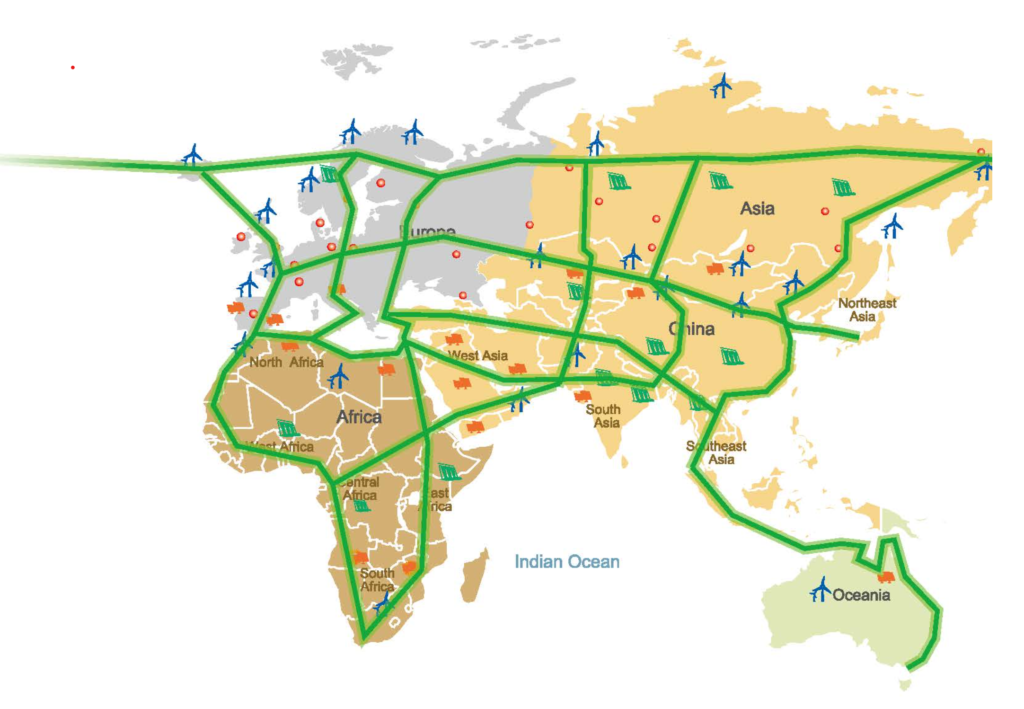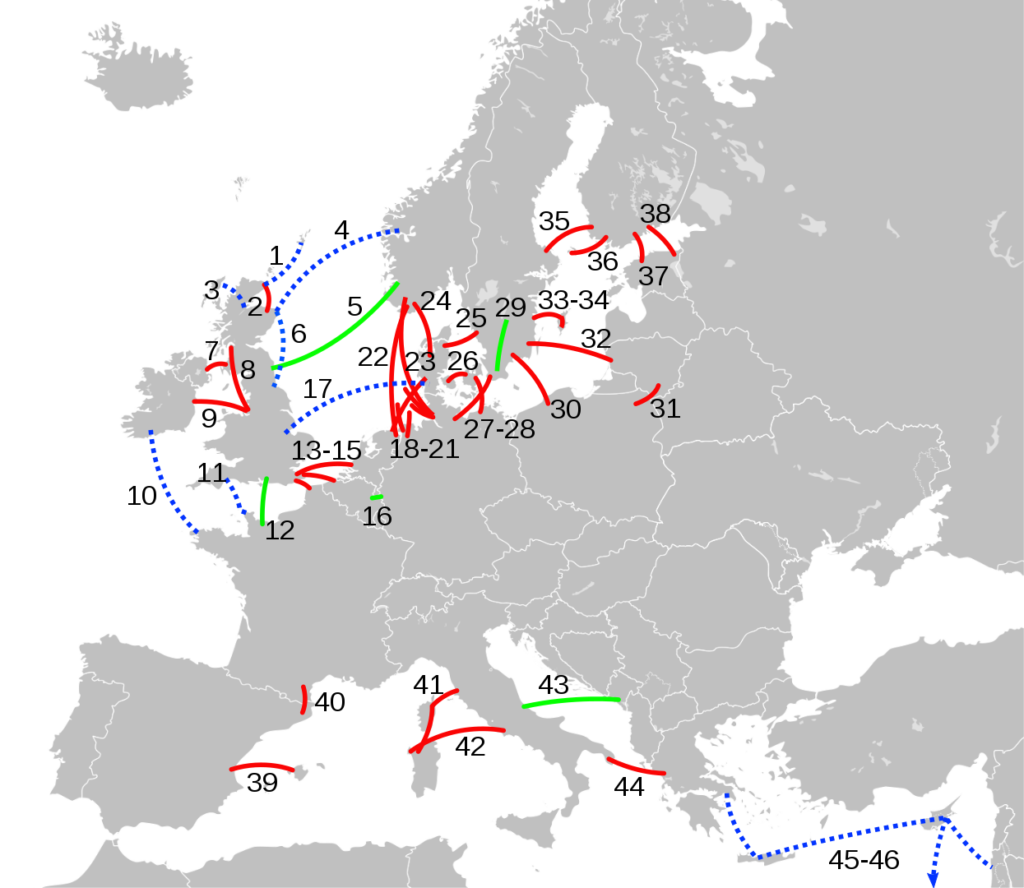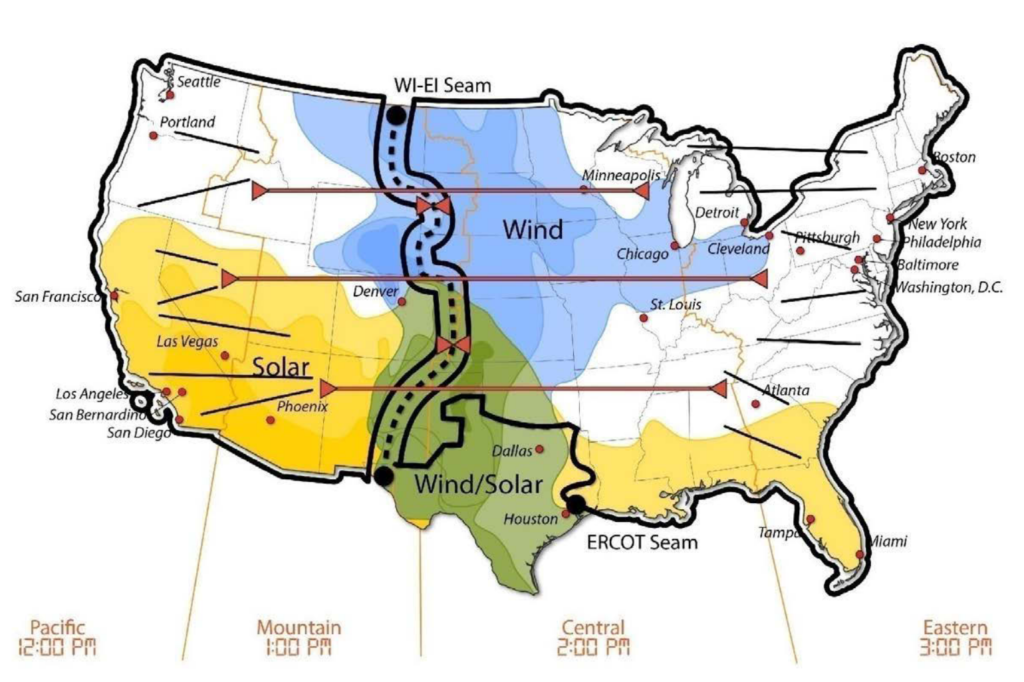The Global Energy Interconnection Development and Cooperation Organization (GEIDCO) was formed in March 2016. The purpose is to promote the sustainable development of energy worldwide. The vision of the Global Energy Interconnection (GEI) is “a clean energy dominant electric centric modern energy system that is globally interconnected, jointly constructed and mutually beneficial to all. It is an important platform for large scale development, transmission, and consumption of clean energy resources worldwide. In essence, GEI is Smart Grid + UHV (Ultra High Voltage) Grid +Clean Energy.”
The idea about super grids is much linked to large scale development of renewable energy – wind, solar and hydro. To move massive amounts, in the gigawatts (GW), of power from these resources over long distances with a minimum of losses to the load centers, UHV transmission will be needed. UHV is defined by GEIDCO as 1000 kV or above for AC (alternating current) and 800 kV or above for DC (direct current).
GEIDCO has grown to some 600 members from 86 countries (2018). It has aligned with all 17 sustainable goals of the UN 2030 agenda. The headquarter is in Beijing, China, and there are regional offices in all continents. The Chairman is Liu Zhenya, Chairman of China Electricity Council. There are four vice chairmen: Steven Chu, former U.S. Secretary of Energy, Masayoshi Son, Chairman and CEO Softbank, Shu Yinbiao, former chairman of State Grid Corporation of China, and Oleg Budargin, former Director General of PJSC Rosseti, Russia).
The Chinese leadership should not be surprising, given that China has become the world leader in UHV transmission. So far China has built 8 UHV AC transmission lines at 1000 kV and 13 UHV DC projects at 800 kV. 4 more UHV AC and 3 more UHV DC transmission projects are under construction. One of the DC projects will be at a record setting 1100 kV, transmitting 12 GW over 3300 kilometers. In comparison the highest DC voltage and AC voltage in North America are 500 kV and 765 kV, respectively.
The GEI goal is to achieve a global super grid, connecting all continents by 2070 with “9 vertical and 9 horizontal channels” (transmission corridors). The approach is “bottom up” starting nationally, followed by regional and intraregional areas, and eventually connecting continents. By 2035 GEIDCO targets regional and intercontinental interconnections in Asia, Europe, and Africa with the 5 first vertical and horizontal channels. By 2050 the target is to have 2 more horizontal and 2 more vertical channels in Africa-Eurasia and the Americas.

Global Energy Interconnection Development and Cooperation Organization. Brochure.
Two of the first proposed super grids were Medgrid and DESERTEC, around 2009/10, both promoting large scale solar development in North Africa and connecting to Europe with HVDC. To support these and similar initiative Friends of the Supergrid was formed. This organization, now called Friends of Sustainable Grids, is a non-profit international organization based in Brussels, Belgium. Members include among others RTE, the French grid operator, and Edison Electric Institute (EEI). The vision and plans are ambitious, but progress has been limited to concepts and plans at large.
In Asia, China has taken a clear lead with the long-distance grid development within China. Following the Fukushima Daiichi nuclear plant disaster, Masayoshi Son founded the Renewable Energy Institute in Japan in September 2011. The Institute has led the conceptualization of an Asia Super Grid. The goal is to “interconnect electric power systems of Asian countries, enabling mutual benefits by exchanging abundant natural renewable energy resources, such as wind, solar and hydropower”. The Renewable Energy Institute is primarily an organization for advocacy and policy research. There is no timeline set for the Asia Super Grid. A possible first step towards the Asia Super Grid may be an interconnection China – South Korea – Japan.
The North American Supergrid (NAS) is a proposed overlay system of “52-node, HVDC, largely underground transmission network that would extend across the lower 48 states” with the purpose to connect large amounts of renewable to load centers. The NAS concept is based on research by Alexander E. MacDonald. It is supported by among others The Climate Institute, Worldwatch Institute, and the Union of Concerned Scientists. The long-term vision is to expand the NAS to also Canada and Mexico. The work so far has been advocacy and studies.
Super grids in Asia, Europe, and Americas, all have two things in common: bold visions and hard realities of technical, economic, and political challenges.
Probably the single biggest factor for only limited progress is that we have not yet reach the “pain point”. The growth of variable renewable energy has so far, by and large, been possible to manage with incremental additions to the existing grids. However, when one starts to get above 50% of variable renewable resources and pushing further towards 70% or even 90% of renewables, it will be exceedingly difficult without access to very strong transmission systems.
The technical challenges, not trivial, look still to be the easiest to solve. In fact, China has already demonstrated that the UHV technology for both DC and AC transmission is here. Europe has demonstrated that the HVDC cable technology works well for both submarine as well as land underground installations.
The economic challenges for super grids are great indeed, not least the huge up-front costs, but several studies show that they can be the lowest total cost over the lifetime of the systems. From a global perspective and given the fact that access to renewable generation is not uniformly spread, generally not close to the load centers and most of the renewable generation is variable, many see the super grids as the most economical approach to get to zero carbon emissions worldwide.
The political challenges are the biggest. How to get countries to agree on making the massive investments? How to agree on cost and benefits sharing between countries? How to make a win-win for countries rich with renewable energy resources and countries with a shortage of them? Will there be public support? Political will and consumer acceptance are intricately linked. Consumer acceptance will depend on the up-front costs being affordable enough to truly support a greener and more sustainable future.
At the local levels there is always the NIMBY (Not In My Backyard) against transmission lines. In Germany, where the consumer acceptance of the energy transition is high, the political will is strong, and the opposition against new transmission lines is even stronger, the SuedLink illustrates both the issue and a solution. The purpose of SuedLink is to move about 4 GW of primarily offshore wind in the north to the load in the south. Originally, SuedLink, covering about 800 kilometers, was planned to be HVDC with overhead lines at a cost of about $4 billion. However, due to a stalemate of massive opposition, in 2016 the German government agencies approved rate recovery of HVDC with underground cables. The cost increased to about $13 billion, but it was concluded to be the only way to be able to move forward with the project.
Even if the super grids look far out, there is substantial progress in expanding the transmission systems. China may be the best example in terms of long distance UHV transmission, but also Europe shows a way forward. Instead of an overlay super grid, there have been a several bilateral, country to country HVDC interconnections. The latest example is NordLink, connecting Norway and Germany with a 1400 MW capacity. The European Commission (EC) has recognized the value of these interconnections to exchange and balance variable renewable resources between countries. Consequently, EC has set a goal that each country must have be able to export or import 10% of its load from a neighboring country. For 2030 the goal will be raised to 15%.

Red: Existing. Green: Under construction. Blue: Planned/Under consideration.
By Reywast92 – Own work, CC BY-SA 4.0 https://commons.wikimedia.org/w/index.php?curid=81851671
In the US progress is more mixed. After, at its time the world-leading, Pacific Intertie project (HVDC and HVAC) in the 1970s, followed by projects like Nelson River, Manitoba, (HVDC), Path 27/Utah to California (HVDC), and Quebec-New England (HVDC) in 1991, progress of long-distance transmission projects has more or less stopped. Private developers like Clean Line Energy Partners have for years worked hard to develop several west – east HVDC projects, for example Green Belt Express, Plains and Eastern, Western Spirit. The 1125 kilometers $2.2 billion Green Belt Express was intended to move wind power from Oklahoma to Tennessee. DOE (Department of Energy) entered a partnership, but it ended in 2018, after it became clear that the states between Oklahoma and Tennessee saw nothing in it for them and resisted the project.
One of the best opportunities to optimize power generation and transmission resources across the United States, could be to increase the transmission capacity between the two large U.S. grids, the Eastern Interconnect, and the Western Interconnect. While these systems are about 750 GW and 150 GW respectively, the ties between the systems are very weak, presently only 1.3 GW through 7 HVDC back-to-back (b-t-b) stations. NREL (National Renewable Laboratory) presented last year (2020) a study of the value of increased HVDC capacity between the two grids. The study calculated benefit/cost ratios for different scenarios of generation. Just expanding the HVDC b-t-b stations to 6.7 GW had for most cases the highest B/C ratio. However, in scenarios of high amount of variable generation (wind and solar) the greatest potential for net cost savings was to expand the HVDC b-t-b, to build three HVDC lines west-east and to strengthen the related AC transmission capacity.

Transmission Design 2B: Three HVDC transmission segments along with expansion of the HVDC b-t-b stations.
Another approach to build out long-distance transmission in the U.S. could be to expand the 765 kV AC network. American Electric Power (AEP), who pioneered, starting in 1967, the U.S. 765 kV bulk power system, proposed in 2007 to expand the existing 765 kV system, which is mainly in Ohio, Indiana, West Virginia, and Virginia, to a national 765kV system at a cost of $60 billion (2007). It could be built incrementally and could fit into a future North American Supergrid.
Supplementary ways to strengthen the existing AC bulk power transmission systems can be to use FACTS (Flexible AC Transmission System) systems, to reconductor existing transmission lines and to deploy technologies like Dynamic Line Ratings (DLR). FACTS system like thyristor-controlled series capacitors (TCSC), static var compensator (SVC), and static synchronous compensator (STATCOM), to overcome issues of voltage drops and losses over long distance AC transmission lines. Reconductoring transmission lines with high performance conductors like ACCC® can double the transfer capacity. Operationally, technologies like DLR can help optimize the transmission system to real-time conditions.
If it is not possible to build enough transmission to support scenarios of 50-70 % or more renewables, the alternatives are more distributed generation, more storage, batteries as well as hydrogen, and more flexible load. With PV (photovoltaic) and battery cost continue to come down, the combination of rooftop solar with batteries will be increasingly competitive and make distributed resources grow. Daytime workplace charging of EVs could further help balancing the electric system at the local level. It all will reduce, but far from eliminate the need for more long-distance and intraregional transmission.
Read more:
North American Supergrid. http://cleanandsecuregrid.org/wp-content/uploads/2017/12/North-American-Supergrid.pdf
NREL The Interconnections Seam Study. https://www.nrel.gov/analysis/seams.html
The Future of Electric Transmission. https://www.orkas.com/the-future-of-electric-transmission/#more-575